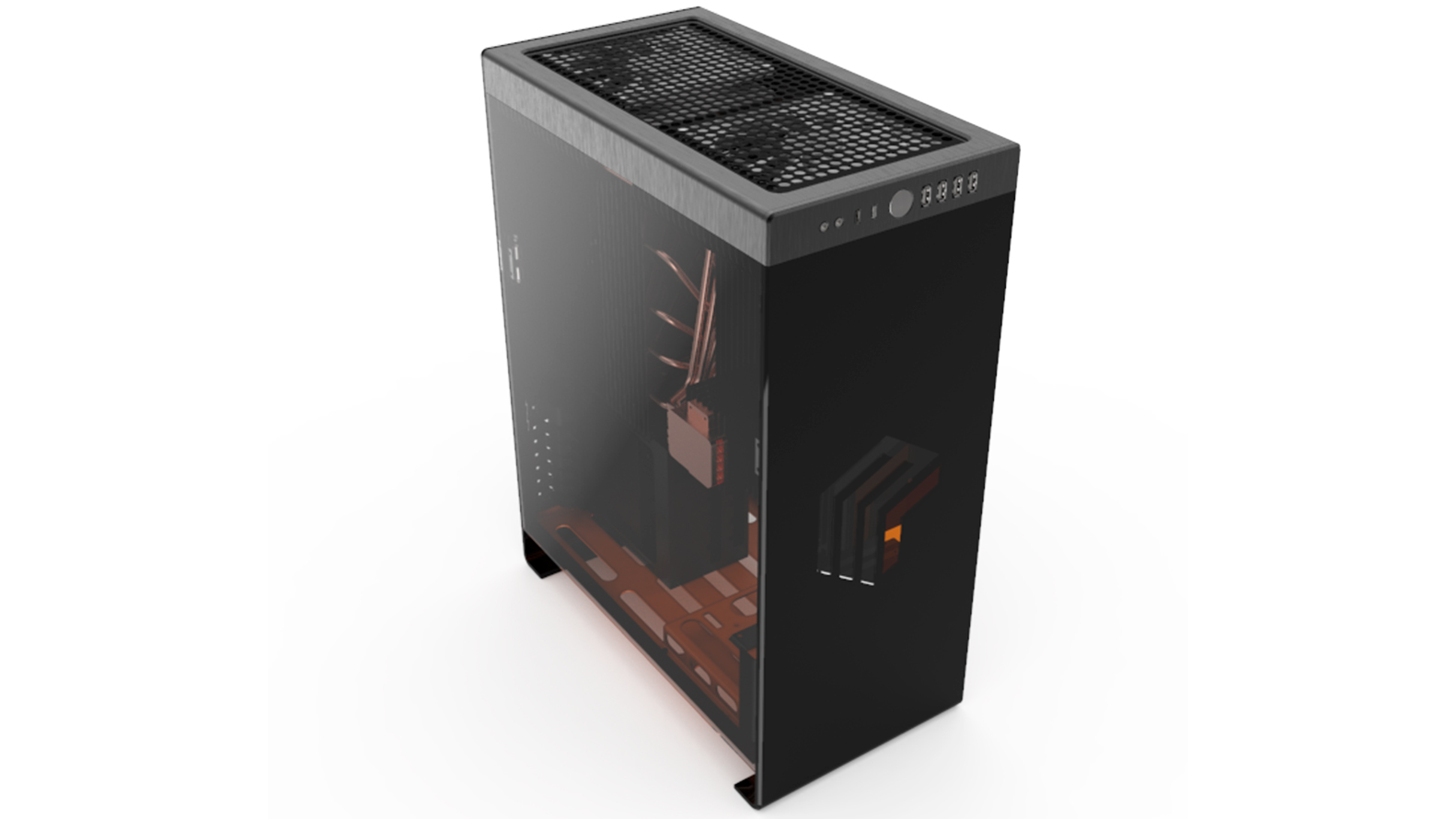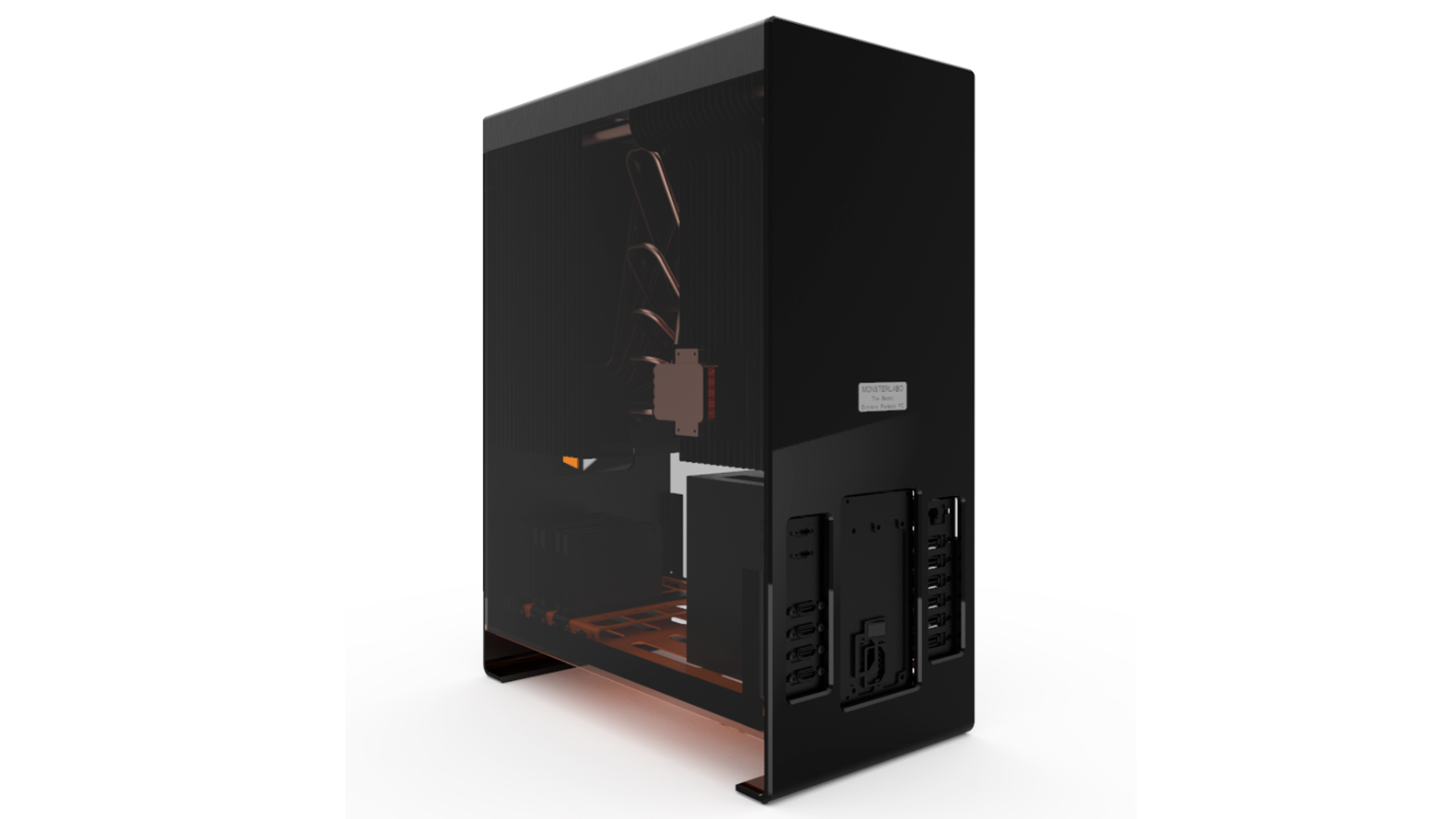MonsterLabo's "The Beast" Lets You Passively Cool Up To 400W Of Heat
Update 15/10/2020 8:30am PT: The second batch of The Beast has gone up for preorder at 680 euro (~$795). The delivery date is set for February 2021. Preorders stop on December 31. The Beast will hit the retail shelves late Q1 2021 with a price tag of 790 euro (~$924).
Original Article:
According to a FanlessTech report, fanless case manufacturer MonsterLabo is gearing up to launch a new ATX case titled "The Beast." The pricing is unknown, but preorders will go up on October 9.
The Beast arrives with dimensions of 450 x 380 x 210 mm. MonsterLabo doesn't specify the exact weight, but it's going to be heavy, for sure. The case's construction includes 2.5mm steel, 6mm aluminum and glass. The appeal behind The Beast is its passive design that allows you to cool both your processor and graphics card. To make this happen, the case incorporates two huge heatsinks, that together amount to a total of 20 copper heat pipes and six copper thermal bridges.
In regards to compatibility, The Beast can house motherboards that span from the mini-ITX to ATX form factors, graphics cards with maximum PCB length up to 290mm and ATX power supplies.




With the passive configuration, The Beast can dissipate up to 400W of heat. MonsterLabo recommends that the processor and graphics card's TDP (thermal design power) don't exceed 150W and 250W, respectively. With the help of two 140mm cooling fans spinning at 500 RPM, The Beast's cooling capacity jumps to 570W. In that case, there's room for cooling a 250W processor and 320W graphics card.
According to MonsterLabo, The Beast can tame Nvidia's GeForce RTX 30-series (codename Ampere) graphics card without hiccups. With active cooling, the case can accommodate SKUs up to the GeForce RTX 3080, which is rated for 320W. We think that the 350W GeForce RTX 3090 is plausible if you pair the case with two decent 140mm cooling fans that have good static pressure.
Get Tom's Hardware's best news and in-depth reviews, straight to your inbox.
The Beast has enough space to shelter up to four 3.5-inch hard drives or eight 2.5-inch hard drives or SSDs. As for outputs, the case's front panel offers one headphone jack, one microphone jack, one USB-C port, two USB 2.0 ports and two USB 3.2 Gen 1 ports.

Zhiye Liu is a news editor, memory reviewer, and SSD tester at Tom’s Hardware. Although he loves everything that’s hardware, he has a soft spot for CPUs, GPUs, and RAM.
-
nofanneeded Passive cooling has no "feel the power" , they are for silent operation not power operation. also they are cleaner and dust does not enter the case.Reply
however , once they use the fans even at 500rpm , they allow dust in eliminating a major positive of a Passive PC. -
derekullo Being able to cool a Ryzen 3950x and a geforce 2080Ti without any fans/noise isn't just a party trick.Reply
This has real world applications for a quiet computing if true
Even with 2 140mm fans blowing at 500 rpm the noise should be extremely quiet.
500 rpm is below the minimum settings for many 140mm case fans which appears to be a practically inaudible 10 decibels.
https://www.chem.purdue.edu/chemsafety/Training/PPETrain/dblevels.htm
https://www.newegg.com/cooler-master-mfx-b4dn-14npa-r1-case-fan/p/1YF-0010-002E3?Description=case fans&cm_re=case_fans--1YF-0010-002E3--Product&quicklink=true
Having said that I will still wait for a review before buying. -
nofanneeded Replyderekullo said:Being able to cool a Ryzen 3950x and a geforce 2080Ti without any fans/noise isn't just a party trick.
This has real world applications for a quiet computing if true
Even with 2 140mm fans blowing at 500 rpm the noise should be extremely quiet.
500 rpm is below the minimum settings for many 140mm case fans which appears to be a practically inaudible 10 decibels.
https://www.chem.purdue.edu/chemsafety/Training/PPETrain/dblevels.htm
https://www.newegg.com/cooler-master-mfx-b4dn-14npa-r1-case-fan/p/1YF-0010-002E3?Description=case fans&cm_re=case_fans--1YF-0010-002E3--Product&quicklink=true
Having said that I will still wait for a review before buying.
I bet that this case would be at least $800 ... and would weight tons .. If you want fully silent PC then it is fine .
But IMO if you want to use 500rpm fans in it , then use water cooling and set the fans at 500 rpm as well on radiators . and fill that case with radiators at the same total price . and choose Radiators with more spacing to lower the Air pressure needed to cool them.
use 3x140 or 3x180 radiators .. each at around $100 .. you can put like 4 of them for $400 -
derekullo Reply
Agreed.nofanneeded said:I bet that this case would be at least $800 ... and would weight tons .. If you want fully silent PC then it is fine .
But IMO if you want to use 500rpm fans in it , then use water cooling and set the fans at 500 rpm as well on radiators . and fill that case with radiators at the same total price . and choose Radiators with more spacing to lower the Air pressure needed to cool them.
use 3x140 or 3x180 radiators .. each at around $100 .. you can put like 4 of them for $400
Hopefully a proper review clears this up.
Even if it was a $400+ cooling device I would imagine it would be more reliable and easier to setup then setting up a custom water cooling rig. -
Olle P I find it difficult to understand how the motherboard is supposed to be oriented.Reply
A graphics card should sit vertically between the stacks of heatsinks?
Also: Will it work with the next gen motherboards, released some 18 months from now? -
CooliPi Replynofanneeded said:Passive cooling has no "feel the power" , they are for silent operation not power operation. also they are cleaner and dust does not enter the case.
however , once they use the fans even at 500rpm , they allow dust in eliminating a major positive of a Passive PC.
Technically, if the radiators are inside the case, then without filters, dust can enter the case. Because major mode of heat exchange is through heating of the air, irradiation is minuscule. Airflow is the king, a filter underside on air inlet would eliminate dust, but also decrease performance.
So, if you want a silent PC, you can have fans, but the deeper they're hidden inside the case, the better for silent operation. If you build a fanless PC, you also get an advantage of no mechanical parts that can break. Those are two distinct design points. I have a Noctua NH-D15 heatsink and even at 700RPM, it's inaudible, thanks to it being inside a Define R4 case. More noise is generated by rotating disks - I don't see any super duper enclosure around the disks in this design. But I have to clean filters once in a while - the case have them hot-swappable, fortunately.
Further regarding this design : placing the fans on the top of it makes them more audible, than placing them underside.
I also miss handles to move it around, or wheels. This is going to be heavy. I also miss pressure derating of its performance, because at higher altitudes, pressure leads to less contact of air molecules, hence lower cooling performance. Irradiation is really minuscule here. Maybe I've overlooked it.
Funny story about our own passive cooler(case) CooliPi - but for Raspberry Pi - which had no compromise design goals regarding both fanless and passive operation - actually the first customer who used it with a recommended Noctua fan responded that its cooling performance is "unreal", after he ordered a fan beforehand before he even got the cooler. :) Well, the design points was that it'd be the best cooler on the block even without a fan, the fan only needed over some >50˚C ambient temperature.
Practically, when using an overclocked Raspberry Pi as a workstation, most of the time it's idling. No fan needed. Only when playing some HD video it's loaded enough that it heats somewhat. And the usage scenario with this abovementioned case may be the same - if you don't load it, you don't have to spin any fans, hence it's fanless and passive. You only need some circuitry to spin a fan only when it's needed.
To wrap it up, even though I've designed my own massive coolercase for the Pi, I'd still go for a somewhat traditional PC case, because of the sound of rotating disks. I bet a user of this case would need lots of storage and rotating disks are still cheapest - and loudest part of contemporary PC. But maybe I'm wrong and the customers with deep pockets can afford some mutli-terabyte SSD storage. But I'd be scared of it's cooling, because the fastest drives come in M.2 form factor, not SATA. Hard to reach them with this heatsink and cool them properly...
... funniest story at the end.The loudest thing of my PC setup is the monitor. Yes, it has two fans. Good old IBM T221 with 16:10 4k screen. Unmatched even today.
